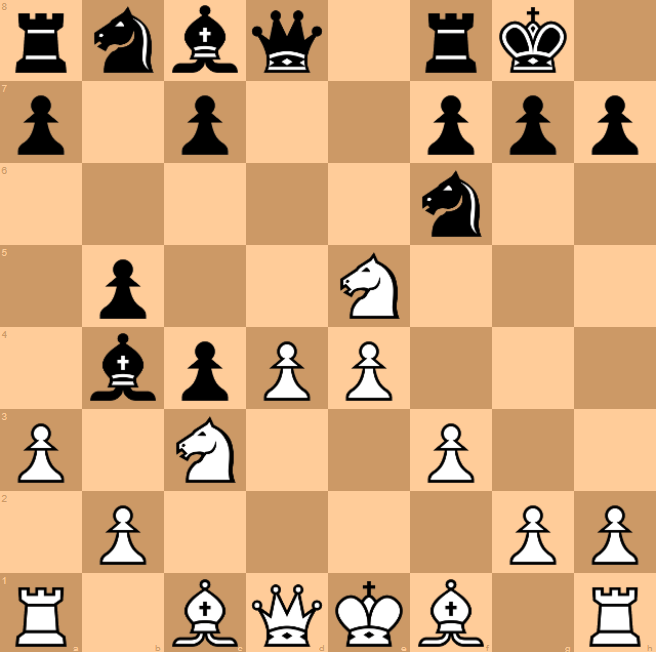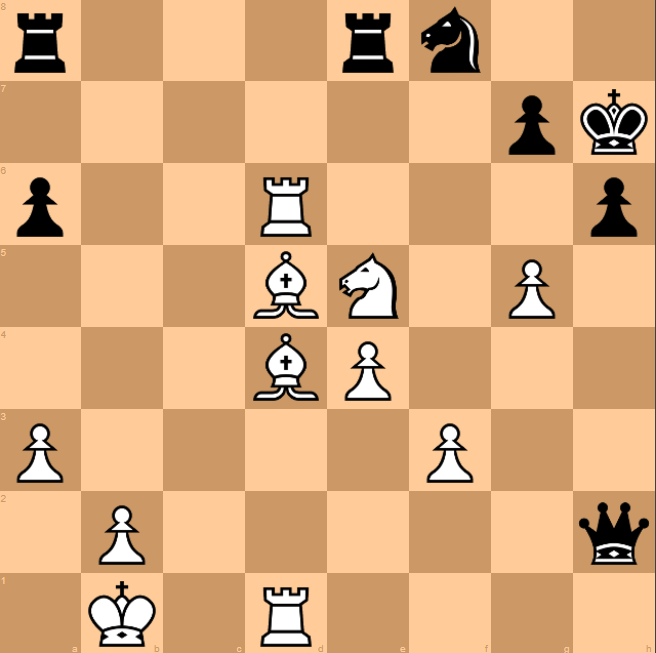La gloire de la France aux échecs

© Lennart Ootes / FIDE
France has scored two notable successes in recent events. In Mexico the rising French star Marc Andria Maurizzi has won the Junior World Championship. The 16-year-old emerged at the top on tie-break, well ahead of the favourite Hans Niemann, the new American prodigy Andy Woodward and Britain’s hope, Shreyas Royal.
Next, the experienced French Grandmaster Maxime Vachier-Lagrave has decisively defeated the world number one, Magnus Carlsen, to take first prize in a high level rapid tournament. Carlsen suffered from the humiliation of having his own weapons turned against him, losing after being worn down in otherwise viable situations. At least, on losing, Carlsen did not throw a tantrum and accuse his opponent of cheating.
The history of chess in France is a glorious one, starting with André Danican Philidor, celebrated for his blindfold displays and recognition of the importance of pawn structure in chess. His unofficial reign as world champion led to an outburst of genius amongst French players, such as Deschapelles, La Bourdonnais and St Amant, which established Paris, with its HQ at the Café de La Régence, as the foremost chess nation on earth. Philidor took refuge in London from the sans culottes of the French Revolution. He was warned by none other than Jean Jacques Rousseau, that blindfold chess would cause his brain to explode. (It did not.)
In 1843 the Englishman Howard Staunton seized the sceptre from France by defeating its champion St Amant. But not so long after in 1858, Paul Morphy, the American Meteor, chose Paris to demolish the superstars, Daniel Harrwitz and Adolph Anderssen. By obliterating the leading opposition, Morphy climbed the highest pinnacle of chess, from which lofty pinnacle he challenged the world to take him on at odds, but received no replies. He promptly abandoned the game at which he had proved uniquely successful.
By the 1860’s France was no longer the epicentre of world chess. In the late 19th century tournaments were dominated by Germanic masters — Anderssen, Steinitz, Zukertort, Tarrasch and Lasker — who largely preferred London to Paris as their base.
After the First World War, France became a refuge for émigré grandmasters, notably Alekhine, Bernstein, Janowski and Tartakower, respectively Russian and Polish. Indeed, until relatively recently, French strength at chess was still bolstered by foreign champions, with Boris Spassky following in the footsteps of Alekhine. Now, though, the French are, once again, quite capable of holding their own, without the intervention of foreign reinforcements, as this week’s games amply demonstrate.
To continue our new and popular format, we shall link all the games following, as is customary, but we shall first examine one in detail, as it bears close scrutiny.
Magnus Carlsen vs Maxime Vachier-Lagrave
AI Cup Division 1 (2023) (rapid), chess.com INT, rd 5, Sep-29
1.d4 d5 2. c4 dxc4 3. e4 e5 4. Nf3 Bb4+ 5. Nc3 Nf6 6. Nxe5 b5 7. f3 O-O 8. a3!

A new move introduced in the game Maghsoodloo vs. Van Foreest (Wijk aan Zee, 2023, 1-0). Until then, theory had recognised only 8. Be3 and a4, neither of which favoured White.
8… Ba5 9. Be3
Deviating from the referenced game where, perversely, 9. a4 was preferred.
9… c5 10. dxc5 Qe8 11. Qd6 Be6 12. O-O-O Qc8 13. Nxb5 a6 14. Nd4 Bc7 15. Nxe6!

White sacrifices his queen in exchange for only a bishop and a very sharp attack. But Black’s pieces are poorly coordinated, with the a8 rook and b8 knight completely undeveloped. When I first saw this game, I thought that Magnus had blundered away his most powerful piece for inadequate compensation. Au contraire, this is a magnificent conception, leaving Black tied in knots, which deserved a better fate.
15… Bxd6 16. Rxd6 fxe6 17. Bxc4 Re8 18. c6 Re7 19. Bb6 Nbd7 20. cxd7 Nxd7
Black is desperate to introduce all his pieces into the scene of battle.
21.Nc6 Re8?!
Of course, not 21… Nxb6, which encourages 22. Nxe7+, winning the black queen. However, the text move is an error. Black should have preferred 21… Kh8 22. Ba5 Nf8 23. Kb1 Rd7 24. Rhd1 Rxd6 25. Rxd6 h6, when his material can still counterbalance White’s positional advantage.
22.Be3 Qc7 23. Rhd1 Nf8 24. Kb1 Kh8 25. h4 h6 26. g4?

White has been accumulating small advantages for some time, even though a direct assault has not yet been launched. But in a razor sharp situation, such as this, wasted tempi permit Black time to activate and reorganise. Better was, 26. Bb3 Qf7 27. R1d3 Rac8 28. Ka2 Qf6 29. Bf2, and White develops an initiative with some activity.
26… Qf7 27. Ne5?!
Ceding more ground with a move that is almost superficial. 27. Be2 is far more solid.
27… Qf6
Black has equalised.
28.Bd4 Qxh4 29. Bxe6 Qh2
Of course, 29… Rxe6 is not only playable, but also marginally superior.
30.Bd5 Kh7 31. g5?!

The simple and materialistic 31. Bxa8!? would have been a more advantageous choice than 31. g5?! This type of mistake is a common feature of rapidplay games. However, the best move is actually, 31. Nf7! It would appear that after 31. g5? Carlsen anticipated 31… Rad8? without adequately or fully assessing 31… Rac8! as can be appreciated by the following possibilities in declining order of preference.
a) 31. Nf7! Rab8 (31… Rac8 32. Ka2 Rc7 33. e5 Ree7 34. Nd8 Rcd7 35. Be4+ Kh8 36. Bc3 Qe2 37. R1d4 Rxd6 38. exd6 Rxe4) 32. Ka1 Re7 33. e5 Reb7 34. Rb1 Qf4 35. Be4+ Kg8 36. Nd8 Rd7 37. Bd5+ Kh7 38. Ne6 Nxe6 39. Rxd7 Nxd4 40. Be4+ Kg8 41. Rxd4 Qxe5 42. Rbd1;
b) 31. Bxa8!? Rxa8 32. g5 hxg5 33. Rg1 (33. Rc6 Re8 34. Nf7 g4 35. Rg1 Qe2 36. Rh1+ Kg8 37. Rc7 Qd3+ 38. Ka1 Ng6) 33… Qf4 34. Rd5 Rc8 35. Ka2 Kg8 36. Nd3 Qxf3 37. Rdxg5 Qf7+ 38. Kb1 Ne6 39. Rxg7+ Nxg7 40. Rxg7+ Qxg7 41. Bxg7 Kxg7;
c) 31. g5? Rac8! (31… Rad8? 32. g6+ Nxg6 33. Rxg6 Rxe5 34. Rdg1 Rd7 35. R6g2 Qf4 36. Rg4 Qh2 37. Bxe5 Qxe5 38. f4 Qd4 39. f5) 32. gxh6 Qc2+ 33. Ka2 Qxd1 34. hxg7 Kxg7 35. Bb3 Qxd4 36. Rxd4 Rxe5 37. Ra4 Rb5 38. Bc4 Rbb8 39. Bxa6.
31… Rac8 32. Rc6?
Seeking exchanges, given the material imbalance, is a sign of failure. White has dissipated the early initiative afforded by his audacious sacrifice, compounding that misdemeanour with a succession of insubstantial manoeuvres. Perhaps best, although still close to losing, is: 32. Bf7 Qc2+ 33. Ka2 Qxd1 34. g6+ Nxg6 35. Bxg6+ Kh8 36. Bc3.
32… Rxc6 33. Nxc6 hxg5?

After this blunder, Black retains a residual advantage, but of the most minimal disposition. The move facilitates access for the queen, also making another escape square available for the king. However, 33… h5! was far more aggressive as the h-pawn is a fast runner and White’s pieces are not well configured to defend this elementary threat.
34.Bf7?
White disdains the opportunity to seize back near-equality with either, a) 34. e5 Ne6 35. Bc3 Nf4 36. Be4+ Kh6 37. Ka2; or, b) 34. Bc3 Ng6 35. e5 Nf4 36. Be4+ Kh6 37. Ka2.
34… Rc8 35. Be5??
A disaster that places Black firmly back in the driving seat. Best was, 35. Bd5 Qh3 36. e5 Rc7 37. Re1 Ne6 38. Bc3 Rd7 39. Bc4, when White is indisputably worse, but still in the game.
35… Qg2 36. Nd4 g4 37. fxg4 Qxe4+?
That Black still has some initiative after this blunder, demonstrates the degree of his former advantage. Correct was 37… Nd7 38. Be6 Rf8 39. Nxd7 Qxe4+ 40. Nc2 Qxe5 41. Rh1+ Kg8.

38.Ka2 Rd8 39. Rf1 Qg2?
Time control, no doubt, looms large. This latest error offers White full equality. Correct was, 39… Rd7 40. Nf3 Rxf7 41. Ng5+ Kg6 42. Nxe4 Rxf1 43. Nc5 Rg1 44. Nxa6 Rxg4 45. Bd6.
- Rf5 g6 41. Rf6 Qxg4 42. Nf3?
Another blunder. White needed to continue, 42. Nc6 Rd3 43. Rf4 Qh3 44. Rf2 Rf3 45. Rh2 Qxh2 46. Bxg6+ Kxg6 47. Bxh2, when Black’s last ten moves of initiative, shudders to a halt.
42… Rd3 43. Bd5?
White continues to blunder along, with Black now completely in the ascendency.
43… Rxd5 44. Rf7+ Kh6 45. Bg7+ Kh5 46. Rxf8 Qc4 47. b3 Qe2+ 48. Bb2 Kg4 49. a4 Qxf3 50. Rxf3 Kxf3 51. b4 g5 52. Kb3 g4 53. Kc4 Ke4 54. b5 axb5+ 55. axb5 g3 56. b6 g2 57. b7 Rd8 White resigns 0-1
Nor were their other conclusive confrontations that day, tame. With the White pieces, MVL, as players and admirers affectionately tag Lagrave, contested a theoretical line of the Sicilian Kan defence, Carlsen goes wrong with 25…f5, when …f6 would most likely have refuted the white attack. But after this terminal oversight, MVL wins after 29 moves.
Maxime Vachier-Lagrave vs. Magnus Carlsen
Of the six games they contested, there was one remaining win for MVL, and again, it was another Queen’s Gambit Accepted. White captures a sacrificed pawn on move 17, which delivers Black an immediate initiative. However, White exchanges queens and proceeds into an endgame with his additional pawn, but which he curiously returns on move 28. This allows Black material superiority shortly after, which he deftly converts for the full point.
Magnus Carlsen vs. Maxime Vachier-Lagrave
Last, but certainly not least, we celebrate the accomplishment of the new World Junior (U20) Champion. Marc’Andria Maurizzi had, in 2021, accomplished the Grandmaster title at the ridiculously early age of fourteen, the youngest French player to have accomplished this feat. Although he won the title on tie-break, the 16-year-old was untouchable, remaining undefeated with some notable victories along the way, finishing with 6 wins and 5 draws.
The opening of Maurizzio’s game, featuring the highly commendable and amazing sacrifices 19. Nd6 and 21. Nb6, is a curious echo of the 1919 game between Richard Reti and Rudolph Spielmann. Apart from the Reti game, also featuring a piece sacrifice for passed pawns, I have never seen anything like it. What makes Maurizzi’s game even more exemplary is the doubly spectacular and voluntary self-impaling of his White knights.
Marc’Andria Maurizzi vs. Ivan Schitco
Grandmaster Keene’s 206th book, “Chess in the Year of the King”, with a foreword by TheArticle contributor Patrick Heren, and written in collaboration with former Reuters chess correspondent, Adam Black, has just appeared and is available from Amazon.
A Message from TheArticle
We are the only publication that’s committed to covering every angle. We have an important contribution to make, one that’s needed now more than ever, and we need your help to continue publishing throughout these hard economic times. So please, make a donation.





